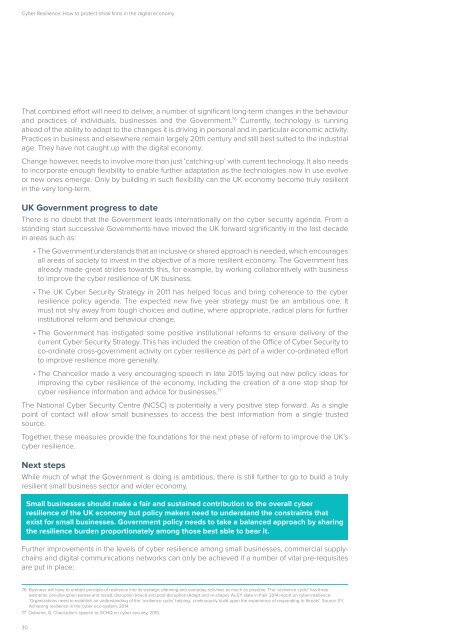CYBER RESILIENCE HOW TO PROTECT SMALL FIRMS IN THE DIGITAL ECONOMY
FSB-Cyber-Resilience-report-2016
FSB-Cyber-Resilience-report-2016
Create successful ePaper yourself
Turn your PDF publications into a flip-book with our unique Google optimized e-Paper software.
Cyber Resilience: How to protect small firms in the digital economy<br />
That combined effort will need to deliver, a number of significant long-term changes in the behaviour<br />
and practices of individuals, businesses and the Government. 76 Currently, technology is running<br />
ahead of the ability to adapt to the changes it is driving in personal and in particular economic activity.<br />
Practices in business and elsewhere remain largely 20th century and still best suited to the industrial<br />
age. They have not caught up with the digital economy.<br />
Change however, needs to involve more than just ‘catching-up’ with current technology. It also needs<br />
to incorporate enough flexibility to enable further adaptation as the technologies now in use evolve<br />
or new ones emerge. Only by building in such flexibility can the UK economy become truly resilient<br />
in the very long-term.<br />
UK Government progress to date<br />
There is no doubt that the Government leads internationally on the cyber security agenda. From a<br />
standing start successive Governments have moved the UK forward significantly in the last decade<br />
in areas such as:<br />
• The Government understands that an inclusive or shared approach is needed, which encourages<br />
all areas of society to invest in the objective of a more resilient economy. The Government has<br />
already made great strides towards this, for example, by working collaboratively with business<br />
to improve the cyber resilience of UK business.<br />
• The UK Cyber Security Strategy in 2011 has helped focus and bring coherence to the cyber<br />
resilience policy agenda. The expected new five year strategy must be an ambitious one. It<br />
must not shy away from tough choices and outline, where appropriate, radical plans for further<br />
institutional reform and behaviour change.<br />
• The Government has instigated some positive institutional reforms to ensure delivery of the<br />
current Cyber Security Strategy. This has included the creation of the Office of Cyber Security to<br />
co-ordinate cross-government activity on cyber resilience as part of a wider co-ordinated effort<br />
to improve resilience more generally.<br />
• The Chancellor made a very encouraging speech in late 2015 laying out new policy ideas for<br />
improving the cyber resilience of the economy, including the creation of a one stop shop for<br />
cyber resilience information and advice for businesses. 77<br />
The National Cyber Security Centre (NCSC) is potentially a very positive step forward. As a single<br />
point of contact will allow small businesses to access the best information from a single trusted<br />
source.<br />
Together, these measures provide the foundations for the next phase of reform to improve the UK’s<br />
cyber resilience.<br />
Next steps<br />
While much of what the Government is doing is ambitious, there is still further to go to build a truly<br />
resilient small business sector and wider economy.<br />
Small businesses should make a fair and sustained contribution to the overall cyber<br />
resilience of the UK economy but policy makers need to understand the constraints that<br />
exist for small businesses. Government policy needs to take a balanced approach by sharing<br />
the resilience burden proportionately among those best able to bear it.<br />
Further improvements in the levels of cyber resilience among small businesses, commercial supplychains<br />
and digital communications networks can only be achieved if a number of vital pre-requisites<br />
are put in place:<br />
76 Business will have to embed principle of resilience into its strategic planning and everyday activities as much as possible. The ‘resilience cycle’ has three<br />
elements: pre-disruption (sense and resist), disruption (react) and post-disruption (Adapt and re-shape). As EY state in their 2014 report on cyber-resilience:<br />
‘Organizations need to establish an understanding of the ‘resilience cycle’ helping…continuously build upon the experience of responding to threats’. Source: EY,<br />
Achieving resilience in the cyber eco-system, 2014.<br />
77 Osborne, G, Chancellor’s speech to GCHQ on cyber security, 2015.<br />
30


